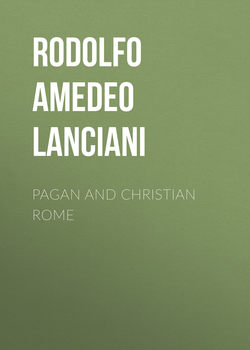Pagan and Christian Rome

Реклама. ООО «ЛитРес», ИНН: 7719571260.
Оглавление
Rodolfo Amedeo Lanciani. Pagan and Christian Rome
CHAPTER I. THE TRANSFORMATION OF ROME FROM A PAGAN INTO A CHRISTIAN CITY.1
CHAPTER II. PAGAN SHRINES AND TEMPLES
CHAPTER III. CHRISTIAN CHURCHES
CHAPTER IV. IMPERIAL TOMBS.94
CHAPTER V. PAPAL TOMBS
CHAPTER VI. PAGAN CEMETERIES
CHAPTER VII. CHRISTIAN CEMETERIES.141
INSCRIPTION COMMEMORATING THE LUDI SÆCULARES CELEBRATED IN THE YEAR 17, B. C
Отрывок из книги
Ancient guide-books of Rome, published in the middle of the fourth century,34 mention four hundred and twenty-four temples, three hundred and four shrines, eighty statues of gods, of precious metal, sixty-four of ivory, and three thousand seven hundred and eighty-five miscellaneous bronze statues. The number of marble statues is not given. It has been said, however, that Rome had two populations of equal size, one alive, and one of marble.
I have had the opportunity of witnessing or conducting the discovery of several temples, altars, shrines, and bronze statues. The number of marble statues and busts discovered in the last twenty-five years, either in Rome or the Campagna, may be stated at one thousand.
.....
The drawings which illustrate my account of the discovery45 prove that the altar rose from a platform twelve feet square, approached on all sides by three or four marble steps, that platform and altar were enclosed by three lines of wall at an interval of thirty-six feet from one another, and that on the east side of the square ran a euripus, or channel, eleven feet wide, and four feet deep, lined with stone blocks, the incline of which towards the Tiber is about 1:100. This last detail proves that when the rough altar of Volesus Sabinus was succeeded by the later noble structure, the pool was drained, and its feeding springs were led into the euripus, so that the patients seeking a cure for their ailments could bathe in or drink the miracle-working waters with greater ease. No attention whatever was paid to the discovery at the time it took place. Instead of reaching the ancient level, the excavation for the main sewer of the Corso Vittorio Emanuele was stopped at the wrong place, within three feet of the pavement; consequently whatever fragments of the altar, of inscriptions, or of works of art, were lying on the marble floor will lie there forever, as the building of the palaces on either side of the Corso, and the construction of the Corso itself, with its costly sewers, sidewalks, etc., have made further research impossible, at least with our present means.
Concerning the celebration which took place around this altar in the year 17 b. c., we already possessed ample information from such materials as the oracle of the Sibyl, referred to by Zosimus, the Carmen Sæculare of Horace, and the legends and designs on the medals struck for the occasion; but the official report, discovered September 20, 1890, produces an altogether different impression; it enables us actually to take part in the pageant, to follow with rapture Horace as he leads a chorus of fifty-four young men and girls of patrician birth, singing the hymn which he composed for the occasion.46
.....